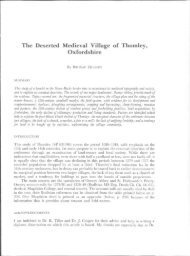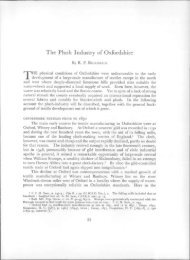Excavations at Wallingford, 1974 - Oxoniensia
Excavations at Wallingford, 1974 - Oxoniensia
Excavations at Wallingford, 1974 - Oxoniensia
Create successful ePaper yourself
Turn your PDF publications into a flip-book with our unique Google optimized e-Paper software.
212 T. J. WEARE<br />
complete description and analysis of pottery from both trenches can be found with the<br />
detailed records. 1o<br />
The majority of wares were medieval, predominantly local and principally ofa sandy<br />
fabric :g2%). The following method of classific<strong>at</strong>ion devised by Maureen Mellor of the<br />
Oxfordshire Archaeological Unit, was adopted. The pottery was examined visually and<br />
classified according to the type of inclusion into three broad groups, I: limestone, II:<br />
flint and Ill: sand or no grains. The pottery was further divided according to the size,<br />
shape and abundancy of the inclusions. [n all, twenty-t'\vo distinct fabric types were<br />
identified. A careful comparison has been made with a fabric type series derived from<br />
m<strong>at</strong>erial excav<strong>at</strong>ed <strong>at</strong> <strong>Wallingford</strong> Castle," g8% of the sherds being of fabric types found<br />
there. Of the sandy wares, go% fell more or less equally into three similar fabric types.<br />
Few imports were found, a foolring of Pingsdorf type ware (No. 6,)" and a glazed body<br />
sherd of a probable Aardenberg-type," being notable exceptions. The local sandy ware<br />
was occasionally thinly glazed and/or decor<strong>at</strong>ed with a white slip (e.g. Nos. '3, 18,42,47,<br />
48)," rectangular rouletting (No. 20)" or combing (Nos. '4 and 50). Incised linear<br />
decor<strong>at</strong>ion (No. Ig) and triangular stabbings were common to handles (Nos. 18 and 49).<br />
A number of cooking-pot rims were decor<strong>at</strong>ed with thumbing (Nos. 6, 26, 3', 40, 52).<br />
Most of the rim forms from sandy wares were simple and not well developed; several of<br />
the flinty wares resemble rim forms from neighbouring sites; Nos. 35 and 36 are similar to<br />
Group B Rinty wares <strong>at</strong> Tetsworth," and No. 65 (Group II) resembles a rim sherd from<br />
Seacourt. 17 Three different forms of tripod pitcher feet were found; Nos. 43 and 45 can<br />
be paralleled with types from Reading Abbey." An unusual sherd (No. 21) is believed<br />
to have been part of a curfew handJe. 1o The hole and blackening of the interior surface<br />
support this interpret<strong>at</strong>ion. The only profile recovered was th<strong>at</strong> of a shallow dish (1 o.<br />
17), the interior surface of which was glazed. Two examples of applied rouletted altern<strong>at</strong>·<br />
ing red and white strips were found (No. 60).'·<br />
The' painted I or white slip wares paralleled \vilh pottery from Abingdon, Oxford and<br />
Reading Abbey are particularly interesting. These wares represent some 4% of the total<br />
wares recovered from l<strong>at</strong>c twelfth to early fourteenth-century deposits <strong>at</strong> Oxford.: 1 The<br />
higher proportion of these wares from this site and from mid thirteenth-century contexts<br />
<strong>at</strong> Reading Abbey as compared with Oxford suggest th<strong>at</strong> these wares origin<strong>at</strong>e to the south<br />
of Oxford, closer to <strong>Wallingford</strong> and Reading. The d<strong>at</strong>ing of the pottery is difficult, as<br />
well str<strong>at</strong>ified deposits from \Vallingford are as yet unknown. However, by analogy with<br />
other sites in the region, the pottery from the backfill of the bell pit (period 2) was thought<br />
to d<strong>at</strong>e to the l<strong>at</strong>e twelfth century while the majority of wares from the burial phase (period<br />
10 See above. second paragraph.<br />
II R, D. Carr. Excaootions <strong>at</strong> <strong>Wallingford</strong> Qutk. '97/J fforthcoming).<br />
The details of this pottery, record ed<br />
by Maureen Mellor. will be lodged with the Oxfordshire County Council Department of Museum Services.<br />
uG. C. Dunning dol.,' Anglo-Saxon Pottery: A symposium', M~dielJOl Archorology, UI (1959), Fig. 28,<br />
N~. 8-13.<br />
13 Similar ~herds were identified by J. G. Hurst and F, Verhaeghe, from <strong>Wallingford</strong> Castle.<br />
14 M. Parrington and C. Balkwill, • <strong>Excav<strong>at</strong>ions</strong> <strong>at</strong> Broad Street', Oxoru~nsia, XL (1975), Fig. 29, No. 67·<br />
Abingdon Fabric A includes <strong>Wallingford</strong> fabrics with while slip j M. Biddle, • Medieval Village of Seacourt "<br />
Oxonitnsia, XXV1,'XXVII (lgGl/2), Fig. 19, NO.7; C. F. Slade, • Excav<strong>at</strong>ion <strong>at</strong> Reading Abbey', Btrkshlre<br />
Archotol. J.t LXVI {1973), Fig. 11, Nos. 3-7. and 12; B. Durham, • 7g-80 St. AJd<strong>at</strong>es', (this volume), Fabric<br />
AG.<br />
IS L. R. A. Grove, • Norman Pottery from <strong>Wallingford</strong> Market Place', Btrkshire Archotol. J., L (1938),<br />
Fig. I, No. I.<br />
Ib M. Robinson, • <strong>Excav<strong>at</strong>ions</strong> <strong>at</strong> Copt Hay, Tetsworth, Oxon. " Oxonimsia, XXXVUI 1973), Fig. 19. Nos.<br />
54 and 62, d<strong>at</strong>ed as early thirteenth century.<br />
11 Biddle, op. cit, note 14. Fig. 22, No. 10, d<strong>at</strong>ed early thirteenth century.<br />
I' Slade, oj). clt. note 14. Fig. I~, Nos. 40 and 49, d<strong>at</strong>ed the first half of the thirteenth century.<br />
19 R. M. Huggins •• Pottery'J In P. J. Huggin~, • Excav<strong>at</strong>ion, <strong>at</strong> Waltham Abbey', MedUvoI ArcJuuoiogYI<br />
xx (1976). Fig. 37, No. 32.<br />
20 Biddle. op. ci/. note 14. Fig. 25, No. I. probably mid· l<strong>at</strong>e thirteenth century.<br />
II Durham, op. cit. note 14 (Phases 8 and 9).













